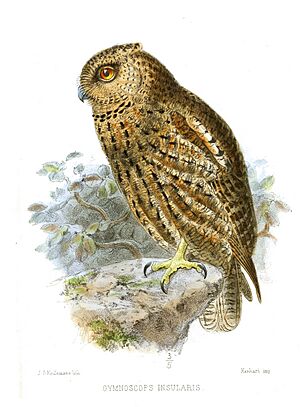Seychelles scops owl facts for kids
Quick facts for kids Seychelles scops owl |
|
|---|---|
 |
|
| Conservation status | |
| Scientific classification | |
| Genus: |
Otus
|
| Species: |
insularis
|
The Seychelles scops owl (Otus insularis) is a very rare type of owl. People also call it the bare-legged scops owl or syer in the local Creole language. This special owl lives only in one place: the Morne Seychellois National Park on Mahé island in the Seychelles.
Contents
About the Seychelles Scops Owl
What Does It Look Like?
The Seychelles scops owl is a small bird. It is about 19 to 21 centimeters (7.5 to 8.3 inches) long. Its wings are each about 17 centimeters (6.7 inches) long.
Its feathers are a reddish-brown color. They have thin black lines running through them. The owl's belly and face are also reddish-brown. Its long, gray legs have no feathers on them. The owl has big, golden-yellow eyes. Its ear-tufts, which look like small horns, are very tiny.
What Does It Sound Like?
This owl makes a unique sound. Its call sounds like a rough "whaugh." It also adds different "tok tok" notes. You can hear its call from far away, especially when it's dark outside.
What Does It Eat?
The Seychelles scops owl is a hunter. It eats small animals and insects. Its diet includes geckos, tree frogs, and insects like locusts.
Protecting the Seychelles Scops Owl
Where Did It Used to Live?
When this owl was first described in 1880, it lived on three Seychelles islands. These islands were Praslin, Mahé, and Silhouette Island.
Why Did Its Numbers Drop?
Over time, the number of these owls dropped a lot. This happened for a few reasons. People cleared the mountainous cloud forests where the owls lived. Also, new animals were brought to the islands. These included rats, cats, and barn owls. These new animals caused problems for the native owls. By 1906, people thought the Seychelles scops owl was completely gone.
Its Rediscovery
Luckily, the owl was found again in 1959. A French scientist named Phillippe Loustau-Lalanne rediscovered it. He found it in a mountain cloud forest on Mahé island. It was living about 200 meters (656 feet) up in the mountains.
Efforts to Help the Owl
In 1999, scientists found the first nest of a Seychelles scops owl. However, the baby owls did not survive. In 2000, they took the first infrared picture of a female owl with her young.
For a long time, not much was known about how many of these owls existed. Because of this, the IUCN (a group that tracks endangered species) listed it as critically endangered. This means it was at very high risk of disappearing forever.
By 2002, more groups of owls were found. Scientists learned that the population was stable, with about 318 owls. However, the number of owls is likely going down again. By 2020, there were an estimated 200 to 280 owls left. People are working hard to protect this special and rare bird.


